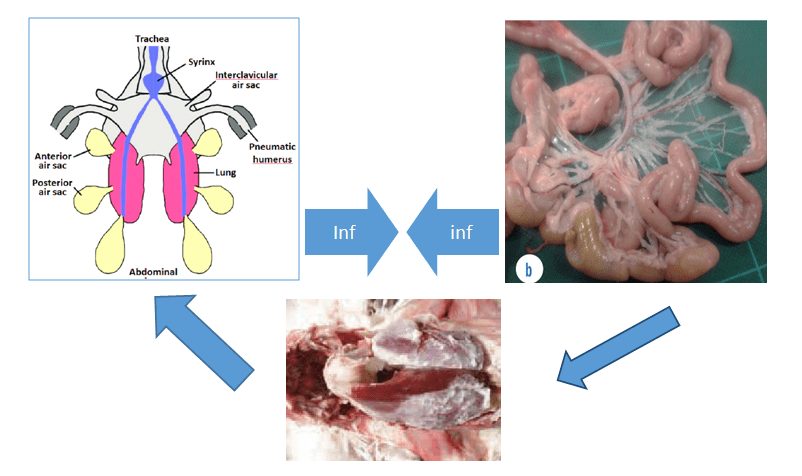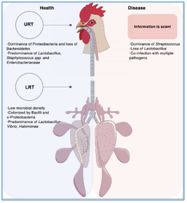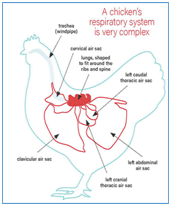Prof. Dr. R.N.Sreenivas Gowda
Founder VC, KVAFSU, Former Director, IAH&VB, Bangalore, Former Prof & Head, Veterinary Pathology, UAS, Bangalore
Respiratory diseases are common in poultry because of its anatomy, physiology and functions. Respiratory infections are caused by Bacteria, Virus, fungi and parasites. Interest in the study of lung microbiota has steadily increased over the last decade, and it is now widely accepted that the lungs harbor bacterial communities like those of the gut, the micro-organisms of the respiratory and gut microbiota play a role in health and diseases.
Introduction
Sustainable poultry meat and egg production is important to provide safe and quality protein sources in human nutrition worldwide. Poultry must have a healthy and functional intestinal and respiratory tract to maintain health and the excellent feed efficiency that is required by modern production standards.
The gastrointestinal (GI) tract of chickens harbor a diverse and complex microbiota that plays a vital role in digestion and absorption of nutrients, immune system development and pathogen exclusion. However, the integrity, functionality, and health of the chicken gut depends on many factors including the environment, feed, and the GI microbiota. Even the low-grade damage to the intestinal tract by pathogenic bacteria may cause poor feed efficiency and decreased rate of gain to escalate the total production costs. In addition, more severe enteric damage by bacterial infection will cause overt illness and high mortality in a poultry flock.
Similarly, the respiratory tract also exposes to the noxious gases like carbon monoxide, ammonia, hydrogen sulfide and other gases that effect the respiratory epithelia and affect the normal microflora providing free passage way for enter of pathogenic bacteria, which not only cause respiratory diseases and also cause enteric problems. This paper deals with the mechanism of inter infections between different systems.
What is the role in Gut-Lung Axis During Respiratory Diseases?
The gut–lung axis or GLA has emerged as a specific axis with intensive dialogues between the gut and lungs, involving each compartment in a two-way manner, with both microbial and immune interactions.
The pathophysiology of the complex respiratory diseases in poultry seems more complex than previously assumed. It has been recently posited that respiratory comorbidities might be partly modulated by the bidirectional inter-organ communication with the gastrointestinal tract, referred to as the gut-lung axis. This new field of research is now investigating how gut microbiota modulates the onset of respiratory infections and whether the airway microbiota in turn, influence host epithelial and immune cells to adjust inflammatory responses at distal sites such gut. Infection can spread from air sacs to peritoneum as seen in mycoplasma and E. coli infection causing peritonitis , perihepatitis and enteritis(fig1)

Fig1. Infection can spread from Lungs and air sacs to intestines and visa-versa Causing Airsacculitis, enteritis, perihepatitis and peritonitis.
The role of Microbiota
The normal intestinal and lung microbiota plays an essential role in the development, and function of the immune system, both locally and systemically. Emerging experimental and epidemiological evidence highlights a crucial cross-link between the intestinal microbiota and the lungs, termed the ‘gut–lung axis’.The gut and lungs are anatomically distinct, but potential anatomic communications and complex pathways involving their respective microbiota have reinforced the existence of a gut–lung axis. Compared to the better-studied gut microbiota, the lung microbiota, only considered in recent years, represents a more discreet part of the whole microbiota associated to Poultry.
Table 1. Common Enteric and Respiratory infections of poultry
| Enteric Infections | Respiratory Infections |
| Bacterial | Bacterial |
| Campylobacter. | Infectious Coryza |
| Botulism. | Mycoplasma infections |
| Clostridium perfringens. | Pasteurella multocida -Fowl Cholera |
| Escherichia coli. | E.coli |
| Listeria. | Streptococcus |
| Salmonella. | Chlamydiosis |
| Shigella. | Ornithobacterium rhinotracheale |
| Staphylococcal food poisoning. | |
| Viral | Viral |
| avian influenza (highly pathogenic) | Newcastle disease |
| duck virus enteritis (duck plague) | Infectious bronchitis |
| duck virus hepatitis. | Infectious Laryngotracheitis |
| infectious bursal disease (hyper virulent and exotic antigenic variant forms) | Avian Influenza |
| Newcastle disease (virulent). | Pneumovirus |
| Corona viral enteritis of turkey | Fowl pox |
| Mycotic | Mycotic |
| Aspergillosis | Aspergillosis |
| Candidiosis | |
| Parasites | Parasites |
| Round worms, Tapeworms | Syngamus trachea |
| Coccidiosis | Oxyspirura, flukes (ducks). |
The Microbiota of Intestines
The microbiota of the gastrointestinal tract is a complex ecosystem predominantly comprised of bacteria, but also contains viruses, archaea, fungi, and protozoa.
The commensal microbiota is attached to the epithelium of the intestine and plays an important role in maintaining homeostasis and in the protection against colonization by pathogens.
The microbiota interacts with the chicken immune system assisting the training and maturation of the immune cells to ensure that commensal microorganisms are tolerated, pathogens are recognized and curbed and those potentially pathogenic commensal microorganisms such as Clostridium perfringens and Escherichia coli are kept in check.
Bacterial Enteritis in poultry
Enteric bacterial infections in poultry pose a threat to intestinal health and can contribute to poor feed efficiency and livability of a flock. A variety of enteric bacterial diseases are recognized in poultry. (see table.1)Three of these bacterial diseases, necrotic enteritis, ulcerative enteritis, and Spirochaetosis, primarily infect the intestine, whereas other bacterial diseases, such as salmonellosis, Colibacillosis, mycobacteriosis, erysipelas, and fowl cholera, affect a variety of organ systems in addition to the intestine.
Viral Enteritis in Poultry
Enteric viruses of poultry are common and pervasive. They are potentially as diverse as enteric bacteria and are responsible for production diseases resulting in substantial financial losses. Many of these viruses have RNA genomes that continually evolve, leading to multiple circulating strains of varying pathogenicity. They can be difficult to diagnose due to confounding issues, such as their presence in healthy birds, variable pathogenicity, age-related resistance, coinfection with other pathogens, and lack of convenient diagnostic tests. They are associated with complex syndromes, such as malabsorption syndrome of broiler chickens and poultry enteritis mortality syndrome, but also of diseases outside the enteric system, such as tenosynovitis caused by avian orthoreovirus and some of the more prominent virus including astroviruses, Coronaviruses, parvoviruses, picornaviruses and rotaviruses.
What is the gut-lung axis concept?
The gut-lung axis concept posits that alterations of intestinal microbiota communities may have a profound effect on lung disease. In other words,the gut-lung axis is the bi-directional crosstalk between the gut and the lungs. Disease in the lung affects the gut and vice versa. These links are facilitated by the gut and lung microbiome,
How does the gut affect the lungs?
The gut microbiota and the lungs are connected in two directions. Simply put, immune cells located in the gut wall can leave the gut and travel through the lymphatic system to other locations around the body including the lungs and, inversely, respiratory infections can alter gut microbiota composition and functions.
The lung microbiota, is the pulmonary microbial community consisting of a complex variety of microorganisms found in the lower respiratory tract particularly on the mucous layer and the epithelial surfaces. These microorganisms include bacteria, fungi, viruses and bacteriophages. The bacterial part of the microbiota has been more closely studied. It consists of a core of nine genera: Prevotella, Sphingomonas, Pseudomonas, Acinetobacter, Fusobacterium, Megasphaera, Veillonella, Staphylococcus, and Streptococcus.They are aerobes as well as anaerobes and aero -tolerant bacteria.
The fungal genera that are commonly found make up the lung mycobiome, in the microbiota of the lung, and include: Candida, Malassezia, Neosartorya, Saccharomyces, and Aspergillus, among others.
Poultry breathing organs: a vulnerable system
Fig.2.Poultry Respiratory System: lungs and air sacs complex
| Poultry have air sacs outside their lungs (fig.2).Air sacs provide the lungs with air continuously, yet they do not participate in gas exchanges. |
They can be compared to a bellows. They are certainly useful for flying birds, but they can be a serious problem in poultry production because organs have slightly vascularized thin membranes, which makes them difficult to treat in cases of infection. In almost all the respiratory diseases they get infected with different degree of lesions and are called air sacculitis.
The air sacs are closely connected to many organs other than the lungs – including bones! Intestines, liver, spleen, and oviduct and are subject to infections. A localized infection of the respiratory system can easily spread to the digestive system or the oviduct and vice versa through pathogen migrations, such as septicemia due to coli bacillary superinfection in poultry.
Colonization of the air sacs of a chicken by E. coli following an infectious bronchitis virus and mycoplasma infection is an example of secondary bacterial invasion. In other cases, the bacterial component of the respiratory disease is the primary initiating cause of the disease. Examples of primary bacterial respiratory disease are infectious Coryzaand Fowl Cholera in chickens.
While the vast majority of studies focused on the bacterial component of the microbiota in healthy and pathological conditions, recent works have highlighted the contribution of fungal and viral kingdoms at both digestive and respiratory levels.
Bacterial communities in the lungs also change in response to changes in the immune status of these tissues. For example, acute lung injury induces an increase in inflammation, which causes distinct changes in the community composition of the lung microbiota. These findings indicate that lung microorganisms play a vital role in maintaining the health of poultry lungs.
Gut microbiota not only plays a role in the resistance to intestinal infection, but also have a systemic effect on antibacterial defenses at sites outside the intestine, such as lung. Therefore the Gut microbiota plays an important role in maintaining body health and resisting respiratory infection.
The gut microbiota dysbiosis impairs pulmonary immune response against MG infection. It has been noted that MG colonization in the lung was significantly increased following gut microbiota dysbiosis, and this could be reversed by intranasal administrated toll-like receptor 2 (TLR2) ligand, recombinant chicken IL-17 protein or recombinant chicken granulocyte-macrophage colony-stimulating factor (GM-CSF) protein. In addition, the levels of short-chain fatty acids (SCFAs) and vitamin A are significantly reduce the gut microbiota dysbiosis, but butyric acid or vitamin A as feed additives promote MG clearance in the lung of gut microbiota dysbiosis group via increasing TLR2/IL17/GM-CSF and host defense peptides genes expression.
It has been determined that gut microbiota can play a crucial role in the defense against influenza virus, Klebsiella pneumonia, and Streptococcus pneumoniae through the “gut-lung axis”.Although the understanding of the “gut-lung axis” is only just beginning, but new evidences showed that strategies to target gut microbiota have the potential to control lung diseases. For example, oral administration of Lactobacillus or Bifidobacterium can reduce the incidence of respiratory infections and reduce the critical degree of the disease. A gut commensal bacterium known as segmented filamentous bacterium, was also reported to promote Staphylococcus aureus clearance in lung. In addition, gut microbiota dysbiosis chickens showed significant defects in immune response to avian pathogenic Escherichia coli and gut microbiota metabolite acetate that significantly inhibited the lung inflammatory injury and reduced bacterial load in lung tissues. Therefore, it can be hypothesized that gut microbiota is a vital factor that modulate susceptibility or colonization resistance to MG.
Conclusion
Gut microbiota metabolites are considered important mediators of gut-lung interactions. Improvements in our knowledge of the gut microbiota have broadened our vision of the microbes associated with the intestine. These microbes are essential actors and protectors of digestive and extra-digestive health and, by extension, crucial for animal physiology. Similar reconsiderations are currently underway concerning the endogenous microbes of the lungs, with a shift in focus away from their involvement in infections toward a role in physiology.
Reference available on request…

